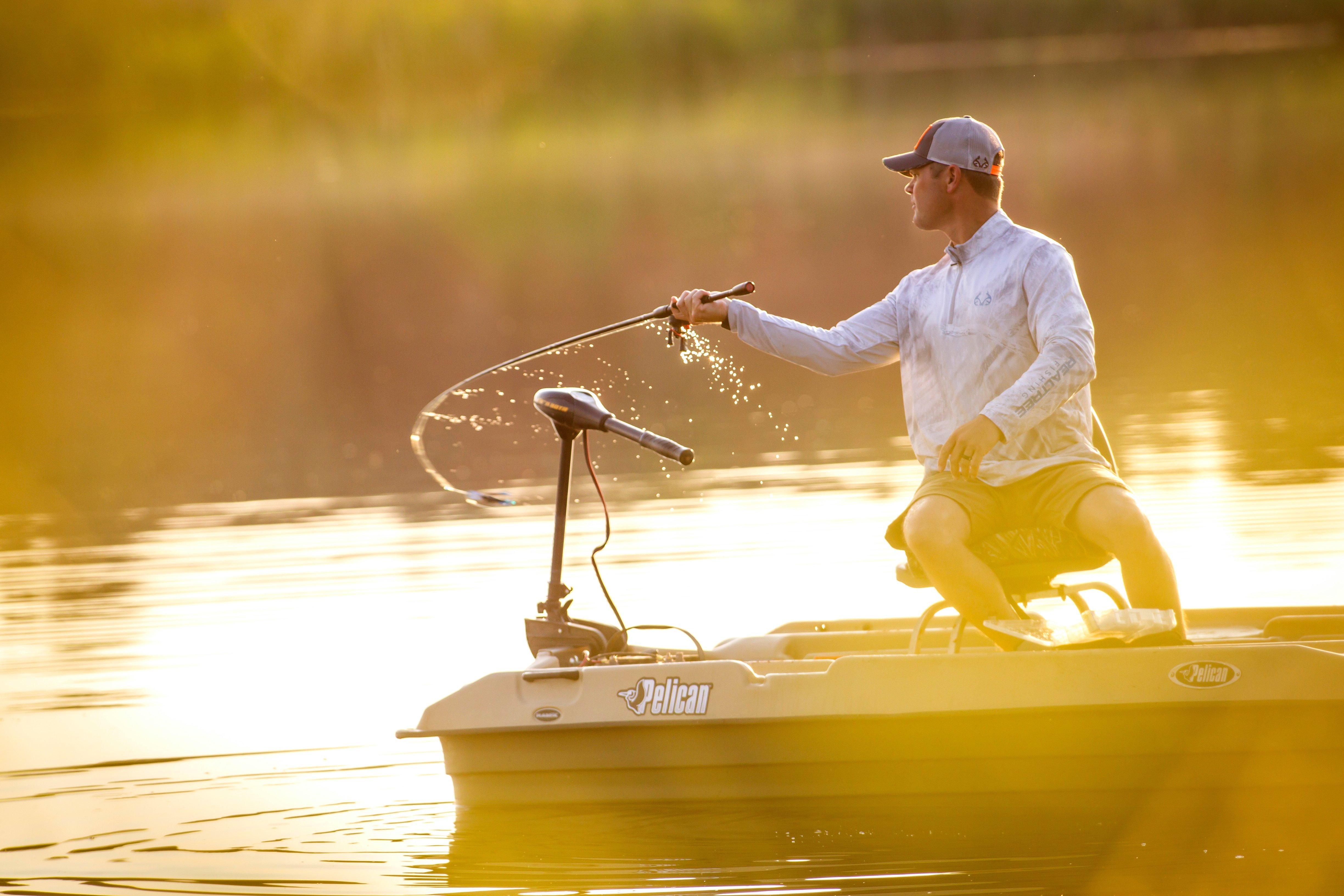There are more specialty rods than ever before, and that’s a good thing. Choosing the right length, power, and action will help you put more fish in the boat

Many fishing rods are adapted to specialized tactics, so selecting the right rod for your needs can be challenging. (Image by Realtree)
Fishing rods have come a long way. Not long ago, the best way to choose a rod, if you were a fairly serious angler, was to simply buy top of the line. Intro models and box-store bargains were heavy, lacked sensitivity and barely lived up to their 1-year warranty.
But things are different today. Advancements in manufacturing have brought consumers quality fishing rods for a range of budgets. Often, rods that are priced at a fraction of the cost of top-shelf models fish just as well. But those extra options can make the shopping process more difficult. Plus, many of today’s more technical fishing tactics have led to the creation of specialty rods that might be ideal for specific lures, but lousy for everything else. In some ways, purchasing the right fishing rod today might be more difficult than ever! So, where do you begin? This will help you cut through the clutter.
ACTION ISN’T POWER
Uncle Gerald used to say “a good medium-action rod will do everything you need it to.” Sadly, Uncle Gerald was wrong. While his idea of a good stick may have carried weight, his favorite rod was not a medium action. Unless it was labeled wrong.

A longer rod hooks and holds more fish, so use the longest rod you can get away with, regardless of what you’re fishing for. (Photo by Realtree Media)
Medium is not a fishing rod action. It’s a fishing rod power, along with ultra-light, light, heavy, and so on. A rod’s action, conversely, can be defined as moderate, fast, extra fast, and more. Uncle Gerald’s preferred rod was a medium power, most likely a moderate action.
Power is fairly self-explanatory. It’s the “stiffness” of a rod. If we take two identical rods of different powers, the lighter-powered rod will flex more than the heavier power under the same load. That load cold be a lure when casting, or a hookset once bit. A lighter power rod flexes more than a heavier power.
Don’t Miss: How to Crappie Fish With Crankbaits
How, and specifically where, that rod bends depends on its action. The slower the action, the more the rod flexes throughout the blank. Again, comparing two identical rods, a moderate action (slow) will bend more in the midsection, whereas a fast action will bend strictly in the tip. If both rods were the same power, they would bend the same amount. But the bend of the slower, moderate action would be seen and felt more toward the handle. The faster action would be “snappier,” bending entirely in the tip section. Most rods built for bass or light inshore fishing are fast actions. To get anything else usually demands a specific order. Fiberglass rods are, by design, slower actions and they flex more in the middle.

Choosing the right rod for the type of fishing you plan to do will make you a more successful angler. (Photo by Realtree Media)
KNOW THE MATERIALS
Not long ago, most fishing rods were made with graphite, glass and boron. Today, the vast majority are graphite or carbon-fiber (just like graphite, but better), or fiberglass blends. Many glass rods actually fish like graphite, though they give a little more. Some anglers rely on them when fishing fast-moving, trebled-hooked lures like crankbaits as the slower response keeps thrashing fish hooked up. For the most part, though, today’s sticks are light and sensitive thanks to space-aged materials and manufacturing. Good for us!
WHAT ACTION DO YOU NEED?
In order to choose a proper fishing rod, it’s best to first define your needs. Casting heavy plugs for muskies, for example, requires a far different rod than slip-bobber fishing for crappies. To chart all the possibilities is impossible.
We’ll start by generalizing. For the most part, tossing light and mid-weight lures is best done with a fast-action rod. That snappy tip is quick to respond to both short, underhand tosses and two-handed bombs. The rod “loads” the lure weight into the tip section, and propels it back forward without added strain in the mid-section. Fast actions excel at casting accuracy.

Consider using a fast-action rod if you plan to toss light and mid-weight lures. (Photo by Bill Konway)
Exceptions occur at each end of the spectrum. When casting extremely light or heavy-weight lures, a slower, more moderate action may be best. Giant plugs can overload most rods, requiring flexibility throughout the blank and a lob-style cast to generate distance. The same could be said for very wind-resistant lures. In the case of ultra-light tactics for panfish or trout, a moderate action will allow the rod to load from movement as much as lure weight, and help to toss the bait.
Moderate actions are also a great choice for many live bait tactics. Here, long leaders may be used (catfish, stripers), possibly corks (sea trout, crappie), or heavy baitfish (snook, musky). All cast best when a rod is able to load down the blank.
Have an artificial tactic that fishes like a livebait rig, like a Carolina rig? Moderate actions may be best there, too.
GO LONG
We’ve yet to discuss rod length, for a reason. While it can be misleading to generalize, I feel confident here: use the longest rod you can get away with, regardless of what you’re fishing for. I don’t own a bass rod that’s less than 7 feet in length, and I often fish with 8-footers. The reason? A longer rod hooks and holds more fish, period. It also casts farther, keeps line higher off the water, and helps you cover more water.

A lighter-powered rod will flex more than a heavier-powered rod under the same load. (Photo by Joe Balog)
Granted, an 8-foot rod won’t work for skipping boat docks, or in the hands of my wife. It’s too overpowering. But only scale-down when necessary. Even for panfish: a 7-foot rod is magic for crappies on small lures.
POWER TRIP
Finally, we need to discuss rod power. Think of it just as it sounds: how powerful do you need your rod to be? Plan to pull a few smallmouths from deep rock piles? Power probably isn’t as important, as the fight will be done in open water. Need to muscle a snook away from a barnacle-laden boat dock? Power is key because without it, that snook will probably snag and break your line.
Don’t Miss: Go Flippin’ for Big Springtime Bass
Many anglers under-power their fishing. This can be by design: light-tackle fishing is a real challenge and great fun. But if you want — or need — to land every fish the bites, it’s best to overpower.

If you want to help ensure you land every fish, consider using a higher-power rod. (Photo by Joe Balog)
Again, looking at my own bass fishing, I rely on medium-heavy or heavy-power rods almost exclusively. Why? Because I live and fish in Florida, and making contact with a big fish can happen at any moment. Factor in heavy cover, and the need for a powerful rod increases.
When I fished more in the Midwest, medium-power rods filled my deck. With panfish today, light powers make up my arsenal. You’ll sacrifice casting distance as a rod becomes more powerful, so the perfect balance is key to combining efficiency with fishability.
Let’s face it, today’s fishing gear can get complicated, even within the same fishing category. There’s a big difference between a 6’10” drop-shot rod and an 8-foot flippin’ stick. Neither can do the job of the other. But that specialization has led to better results and more fish in the boat. Good, specialized rods are no exception, and having the right stick for the job will make you a more successful angler.












